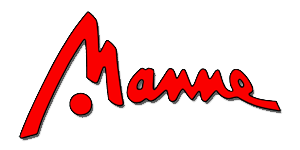Woods
Neck
- Maple – Acero – Acer Platanoides, Italy
- European Beech – Faggio – Fagus sylvatica, Italy
Fretboards – resin (rocklite) or on request in Ebonprex: https://www.manne.com/news/ebonprex/
Top:
- Italian Poplar – Pioppo – Populus nigra “italica”, Italy
- Italian Walnut – Noce – Juglans regia, Italy
- Yew – Tasso- Taxus baccata, Italy
- Maple – Acero – Acer Platanoides, Italy
- Spruce – Abete – Picea Excelsa, Italy
Body e Top:
- Paulownia Italiana
- Chestnut Italiano delle piccole dolomiti
- Platano italiano
- White/black Korina -Terminalia Superba, Congo (FSC /PEFC)
- Ash – Frassino – Fraxinus excelsior, Italy
All wood we use comes from a responsible wood management for certified and sustainably managed forests.
Alder (Alnus glutinosa-italiano; Alnus rubra-americano)
It Is difficult to find European Alder with good dimensions and without defects as the trees are not growing big enough. So, even if its sound was not bad we started to buy American Alder, more pink in colour, also available in high quality. It has a good texture and consistence but as our mainstream body wood we decided to use the more versatile korina.
Ash (Fraxinus excelsior)
Unlike the American swamp ash, the European ash is very heavy and very hard. For years we used it for our bass bodies. Then we started to use it together with our laminate for the necks and we discovered that most of the brilliance of the sound came from it, and not from the body weight. So we started to take off weight from the body getting a responsive and balanced sounding instruments. We still use Ash for TAOS body when a cutting sound is needed, with power, attack, punch and high harmonics that some kind of rock/metal players appreciate.
Basswood (Tilia platyphyllos)
Its colour is light yellow and its consistence is fibrous, it can be rather heavy but also lighter boards can be found. It is usually free from defects and boards hasve good width. This wood is our favourite for the body of Soulmover and Semiacustica, with its “V shaped” sound response.
Beech (Fagus Silvatica)
One of the majestic and common trees of European forests. Light or darker Pink/brown colour is used for Manne instruments’ laminated neck central core. Parallel grain, phenolic gluing for the responsable part of our neck’s strenght and reliability.
Chestnut (Castanea Sativa)
similar to Ash in consistency and texture, but lighter gives a bold response , fast and open. The chestnut we are using is logged few km from our shop, in the”Piccole dolomiti” area , certified PEFC. https://www.manne.com/news/castagno-pfec-piccole-dolomiti/
Korina (Terminalia superba)
This is one of the “myths” in musical instruments, as in the mid ’50 gibson used it for their more “progressive” instruments. These enormous African trees were declared at risk, but now, due to efforts in the 50s to preserve natural supply of the wood, the supply is fully granted. This species is reported to be relatively secure, with little or no threat to its population, within its natural growth range, according to the World Conservation Monitoring Center in ’92.
The main problem using korina is that its features of weight density and sound varies drastically from one board to the other. So we take great care and we use each piece for its proper use. We like it much more than classic mahogany as it it very resonating, and sounds more neutral, so it can also be easily associated to other woods.
Mahogany (Swietenia-americano, Khaya ed Entandrophragma-africani)
Each time I went shopping for mahogany I found there are so many different types and they all sound so different, that it is always difficult speaking about it. We still have some heavy and light mahogany pieces left but we keep them just for special projects.
Maple (Acer Platanoides / Acero riccio)
Traditionally used for his strenght and fiber. The European we use has a white colour that sometimes fades to a light shade of pink. We use it mostly for the side parts of guitar necks and some flamed tops for the body. We usually use burl poplar for tops but is some special cases when a more bright edge is desired we also use Maple. Top materials can be important for the final sound result on TAOS and MOAB or TREA as they are half of body thickness. On Ventura and Newport, where the top is typically 6mm, they give less contribution but it can still be noticed.
Paulownia (Paulownia)
Cut in Italy , is a wood that replaced poplar in forestry as is the fastest growing tree. Extremely light, so soft that we reinforce all the areas that will be prone to mechanical stress with inserts of beech. The tone you get is soft , acoustic, slightly compressed. The very light colour gives brilliant shades possible. https://www.manne.com/news/to-paulownia-or-not-to-paulownia/
Poplar (Populus)
There are so many different species of poplar that we can quote what we wrote about Mahogany. WE use it for our tops. That is a true hunt!! In the right season we use to inspect a hundred cubic meters of trunks and boards, and even freshly cut trees, looking for the right consistency, colour and wood grain. The specie we look for has yellow and pink striped sections with striking flames and curious textures.
Spruce (Picea Abies – Abete bianco o Picea Excelsa – abete rosso maschio)
Is the first choice for resonating top of acoustic instruments. Light and resonant it has different sound nouances depending from its provenance. Soil, light, temperature affect its growth and his properties, making possible for the liuther to choose different sound options. Our Acoustics guitar line sports beautiful sitka spruce, with a golden colour and classic american sound reference, or italian “Val di fiemme” spruce, the Stradivari favourite wood, that has a paler colour lightly shading to yellow and a louder voice especially appreciated by fingerpickers. For Manne instruments we use it as body top for the Acoustibass and the Semiacustica, even if its tone contribution does not play a key role in those instruments.
Sycamore (Platanus Acerifoglia)
It Is named Sycamore in Great Britain while in USA its name is Maple. It was used in the 15th and 16th century for fretboards and sides and backs of lutes. Its colour can go ochre yellow to dark brown (especially if it is naturally dryied) and can have flames and curious textures. The sycamore we seldom use, comes from Italy. It is a perfect substitute for Mahogany, it is light, with a warm sound that we like so much. The big problem with Sycamore it is that is not a commercial wood so it is not easily available and sometimes its quality is very poor.
Walnut (Juglans regia)
One of the luxury wood in Europe, it can go fron yellow/brown to dark brown that sometimes is almost black. It is a wood that give a very dark sound to instruments so we use it wisely, never as full body. Its core is sometimes dark striped, with classy and spectacular look. Even on our Newport, just a 6 mm walnut top adds a lower dimension that makes the sound deeper and bigger.
Yew (Italian)(Taxus baccata)
It is a rare conifer tree and, as it has a very slow growth, this wood is precious and available in small quantities. Its colour is brown-red, cream striped, very unusual and unique. Altough light, it is consistent and it well defines the treble frequencies when used as a top for a Korina body.
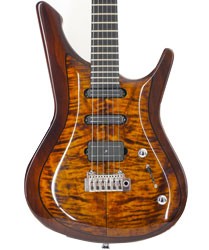
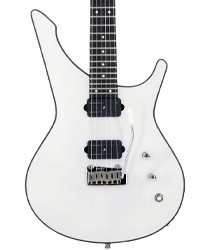
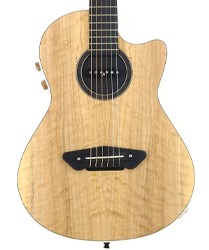
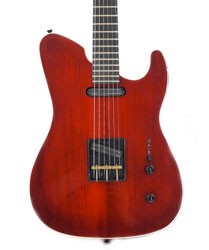
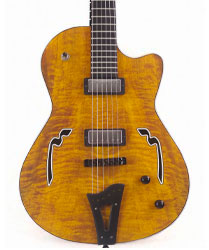

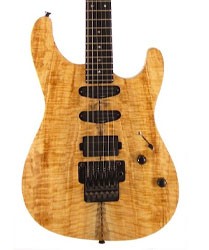

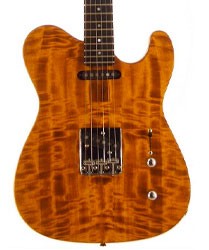
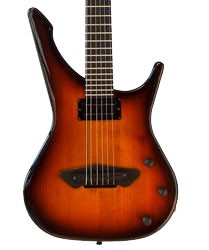
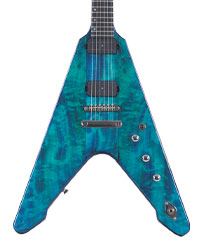

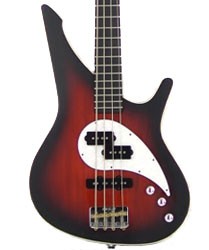
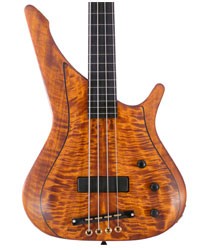

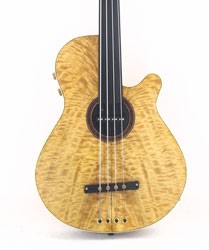
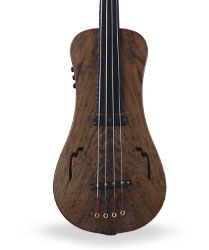

 Italiano
Italiano